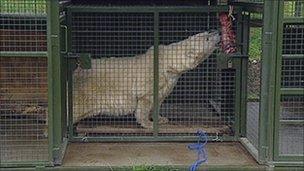Highland Wildlife Park's polar bear weighed
- Published

Mercedes steps on to scales set up inside her enclosure
The UK's only polar bear has been weighed to help her keepers determine the state of her health.
Mercedes, who weighs 291kg (45 stone), was moved from Edinburgh Zoo to the Highland Wildlife Park at Kincraig in the Cairngorms last year.
Her estimated age of 29 is old for a polar bear, but wildlife park staff said she was healthy.
She is thought to have gained some weight after losing some following her arrival in the Highlands.
For the weighing process, Mercedes was "trained" to step on to mechanical scales in her enclosure.
Animal collection manager Douglas Richardson said the scales were placed in a small passage which connects her two roofed den areas.
He said Mercedes was "quite gentle" for a polar bear, but staff still had to be careful when working close to her - even when separated by a wall of steel mesh.
Mr Richardson added: "The real drive to get her weighed accurately is to allow us to carry out a comprehensive health check.
"She gives all the signs of being in perfect health, but she is at the upper end of a polar bear's lifespan and we want to ensure that we are not missing any potential age-related problems that may reduce her quality of life if they are not dealt with.
"All wild animals are pre-conditioned to hide illness to avoid predation or harassment, and a zoo polar bear is no exception, so her pending health check is very important."
Researchers studying polar bears in the wild said last year that the mammals had shrunk in size over the past century.
Scientists compared bear skulls from the early 20th Century with those from the latter half of the century.
Their study, in the Journal of Zoology, described changes in size and shape that could be linked to an increase in pollution and the reduction in sea ice.
Physical "stress" caused by pollutants in the bears' bodies, and the increased effort needed to find food, could limit the animals' growth, the team said.
The researchers used the skulls as indicators of body size. The skulls from the later period were between two and 9% smaller.